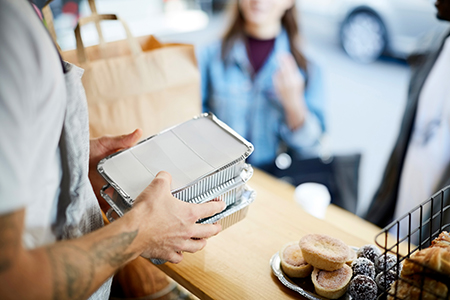By Haley Herfurth
UAB News
Feel free to order that pizza or call in for curbside pickup at your favorite local restaurant: The risk of contracting COVID-19 through food delivery or pickup — the packaging or the food itself — is low, according to leading health organizations and Jodie Dionne-Odom, M.D., assistant professor in the University of Alabama at Birmingham’s Division of Infectious Diseases.
Food delivery has been recommended as a simple way to maintain social-distancing practices during the global COVID-19 outbreak, because there is little risk of virus transmission through food itself, says Ian Williams, Ph.D., chief of the Outbreak Response and Prevention branch of the United States Centers for Disease Control and Prevention, which investigates food and waterborne illnesses.
The United States Food and Drug Administration and the United States Department of Agriculture concur; no organization has reported that COVID-19 can be transmitted by food or food packaging. The biggest risk of transmission, Williams says, is in exposure to individuals who are symptomatic.
“There is no evidence out there, so far with [COVID-19], that it’s foodborne-driven or food service-driven,” Williams said in an information webinar. “This really is respiratory, person-to-person. At this point, there is no evidence really pointing us toward food [or] food service as ways that are driving the epidemic.”
Food packaging also poses little risk; Dionne-Odom says she encourages people to continue shopping for needed items, including food, via delivery services. Just remember to wash your hands frequently, she cautions.
“Packages will be coming from a number of hands, and you might not know the symptom status of everyone who touched it along the way,” Dionne-Odom said. “Wash your hands after opening and handling the package. That will kill the germs.”
To minimize the risk to households frequently utilizing curbside pickup services, Dionne-Odom recommends designating the same person to pick up the order each time.
“Ideally, this person would not be symptomatic, be under the age of 60 and have no chronic medical conditions,” she said. “It makes it simplest for them to have a procedure for each time they come and go — washing their hands carefully every time they enter and exit the home.”
For those who live in a walkable community, Dionne-Odom says walking to pick up takeout can be a healthy activity to prevent feeling stir-crazy and engage your body during periods of isolation.
“We want people not to go crazy sitting inside,” she said. “It’s OK to go outside and get fresh air. You always want to maintain that 6 feet of separation from others, but we encourage people to get outside for their mental health and for all the other reasons it’s good to get outside.”




